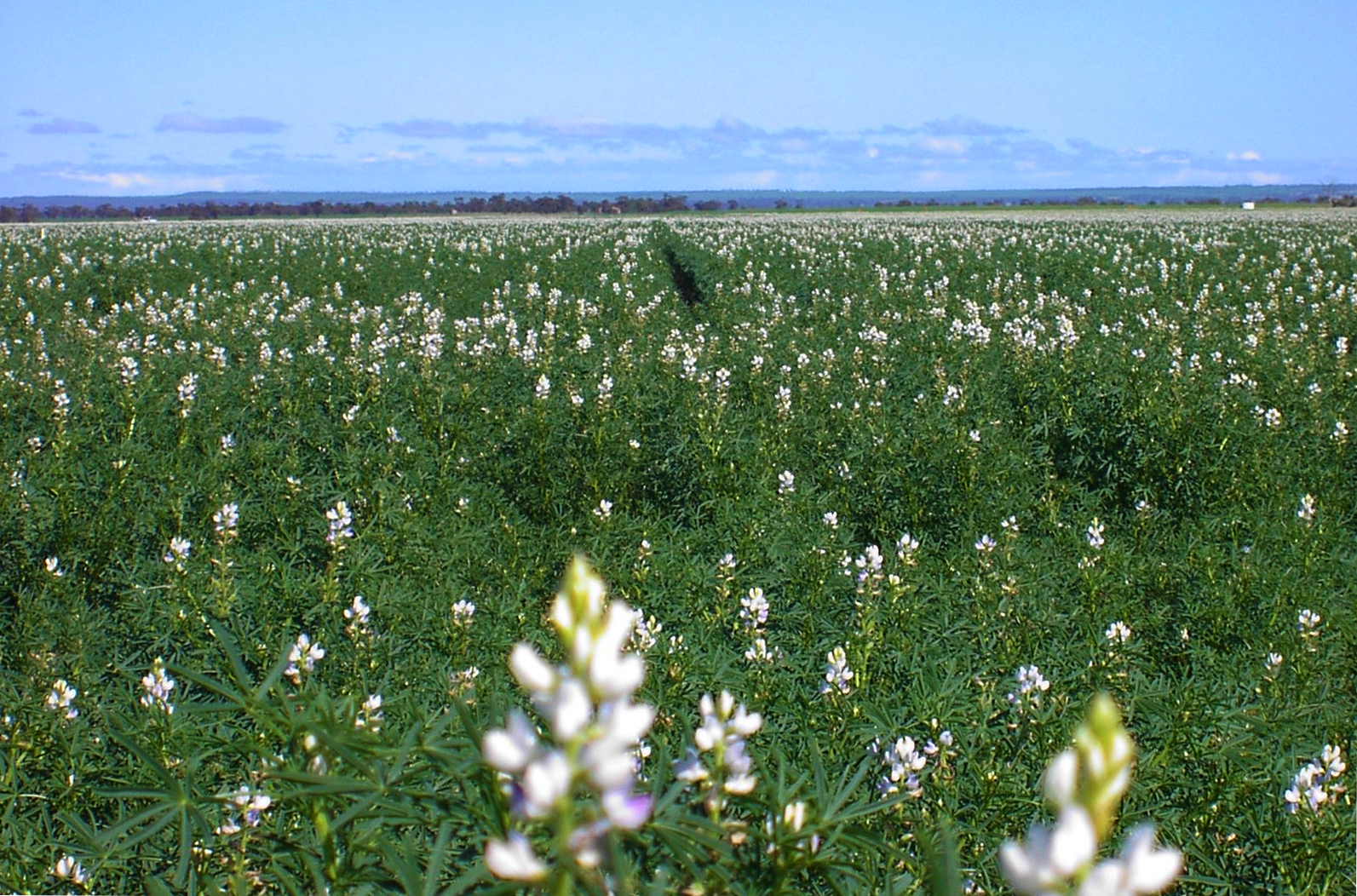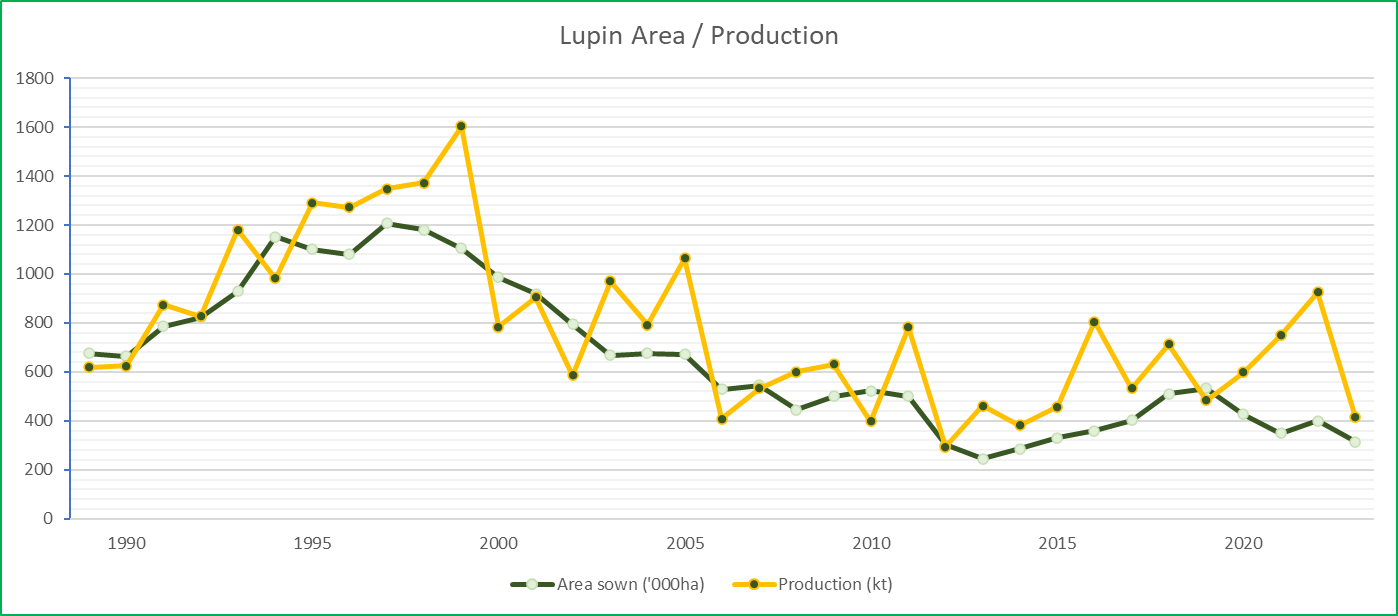
Western Australian lupin industry
Lupin has recently gained attention for its health benefits with a unique combination of high protein, high fibre, low oil and virtually no starch.
Since the release of the first fully domesticated Australian sweet lupin in the late 1960s, lupin breeding by the department has resulted in a doubling of lupin yields from 0.7 to 1.5 tonnes per hectare. The majority of Western Australian lupin is exported as animal feed to the European Union, Japan, and Korea.
The Australian sweet lupin has a low glycaemic index and there is increasing evidence it could have a place in combating obesity and associated health problems of diabetes and heart disease.
Lupins are uniquely suited to the acid and sandy soils found across large tracts of the Western Australian wheatbelt and play an important role in breaking cereal disease cycles and adding fixed nitrogen to cropping systems.
Production in Western Australia has declined since its peak in the late 1990s with a current gross value of production of around $200 million.

Health benefits of lupins
Research has shown that consuming foods enriched with Australian sweet lupin can provide a feeling of ‘fullness’ and result in people eating less and consuming fewer kilojoules. Other possible health benefits include a more balanced blood glucose level, a lowering of cholesterol and improved bowel health.
While the closing of Lupin Food Australia's processing plant in 2016 reduced the capacity of lupin processing in WA, other companies, such as Irwin Valley, Coorow Seeds, The Lupin Co., Wide Open Agriculture, and Kalgrains are processing lupins for food or feed.
Increased processing capacity will enhance the potential for lupins to be used in food products that could help lift the price of lupins and stimulate increased production of this grain legume across southern Australia.
Lupin can be used as an ingredient in a variety of foods including pasta, pancakes, and baked goods such as pastries and pies.
Production
Lupin production expanded rapidly in Western Australia through the 1980s and 1990s before weed issues and low prices resulted in many growers opting for a canola (or fallow in low rainfall areas) rather than lupins in rotation within cereal systems. As a result, production fell from a high of 1.5 million tonnes in 1999 to a low of just below 300,000 tonnes in 2012.

WA Lupin area and production 1990 to 2023
It is hoped that the new variety Rosemont, coupled with the continued promotion of lupins as a human health product, will lift lupin production across southern Australia, where a legume rotation is very much needed.
The department supports the pre-breeding, breeding, agronomics, and market development of the WA lupins industry, in conjunction with industry partners.
Markets
Lupins have a unique combination of high protein, high fibre, low oil and virtually no starch.
Most lupin production is used by stockfeed manufacturers for animal feed, with ruminants (cows and sheep) the largest market, followed by pigs and poultry. There is small but increasing use of lupins in aquaculture.
While less than 4% of global production is consumed as human food, it is estimated that about 500,000 tonnes of food containing lupin ingredients is consumed each year in the European Union — mainly through the inclusion of low rates of lupin flour in wheat-based bakery products.
About 40% of lupin production in WA is retained on-farm as stockfeed and seed or traded on the domestic market to supply the sheep, dairy, pig, and poultry industries.
Lupins generally compete against soybeans in export markets and are typically valued at 70–75% of the price of soybean meal. WA accounts for most Australian lupin production and exports. WA is effectively the sole exporter of lupins into the large international market for vegetable-based proteins for the livestock industries.
South Korea is a major buyer of WA lupins and has a large capacity dehulling plant, with the hulls used in animal feed and the kernels in pig feed rations. Other markets include the Netherlands, Vietnam, and Belgium. Most markets use lupins for animal feed, although small human food markets are developing.
Crop Sowing Guide
The Western Australian crop sowing guide is a one stop shop for information on all the major crops grown in Western Australia, compiled by the department. This edition includes the major crops grown in WA – wheat, barley, canola, oat, lupins, and pulses. The guide aims to provide information to support growers with decisions on the best choice of variety for each of the major crops for the upcoming season.
View the current Crop Sowing GuideDiseases and pests of lupins
When selecting a lupin variety for your cropping program, it is important to be aware of the variety's disease and pest package to allow for appropriate planning and proactive management to reduce risk of yield losses.
The severity of disease in lupin crops depends on the presence of inoculum carried over from last season, favourability of seasonal conditions, pathotype virulence, and varietal susceptibility.
An annual review of your crop’s disease and pest resistance ratings is vital, as risk profiles change with the introduction of new pathotypes. Refer to the Western Australian crop sowing guide below for lupin variety NVT disease ratings, and lodging, disease and insect ratings for narrow-leaf lupins in WA.
A rapidly developing issue for the Australian grains industry is development of fungicide resistance in a range of lupin pathogens. Using a good Integrated Disease Management (IDM) approach can help reduce reliance on fungicides for disease management. More information on fungicide resistance is available from the Australian Fungicide Resistance Extension Network.
Pest insects and nematodes can have adverse and damaging impacts on agricultural production and market access, the natural environment, and our lifestyle.
Western Australia is free from some of the world's major pest insects. Biosecurity measures on your property are vital in preventing the spread of insect pests.
The department provides:
- biosecurity/quarantine measures at the WA border to prevent the entry of pest insects
- where relevant post border biosecurity measures
- advice on widespread pest insects present in the state
Disease symptoms, background, diagnosis, factors favouring risk and spread, yield and quality losses, and integrated management strategies are provided for the following diseases of lupins:
Soil-borne pathogens and nematode pests infect plant roots and impact their ability to take up water and nutrients. Environmental factors such as soil moisture, temperature and nutrient availability will determine the severity of disease development. Soil-borne diseases and nematode pests are best managed by identifying the pathogens or pests causing plant decline, using crop and variety rotation, and chemical management, if available.
Nematode pests
Nematodes are microscopic, worm-like animals that feed on plant roots causing damage and yield loss in susceptible crops. Crops infested with plant parasitic nematodes are more susceptible to infection by fungal diseases such as rhizoctonia root rot.
Root lesion nematodes
Lupin crops are more prone to invertebrate damage than cereal crops and need to be checked at critical periods for pests. The critical times for monitoring are:
- Cutworm
- Lucerne flea
- Native budworm
- Managing aphids and viruses in lupins
- Native budworm spray thresholds
- Pest slugs and snails and their management
- Red legged earth mite (RLEM)
Related links
- Lupins - essentials for growing a successful crop
- Sclerotinia management for narrowleaf lupin crops in Western Australian farming systems
- Registered fungicides for broadacre crops
- Australian Fungicide Resistance Extension Network
- GRDC National Variety Trials | Grains Research and Development Corporation
- Subscribe to the Grains Convo Newsletter

